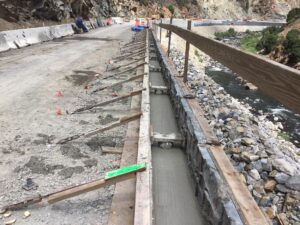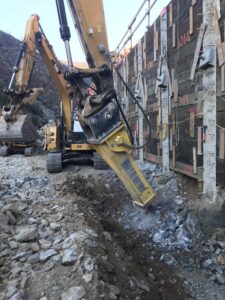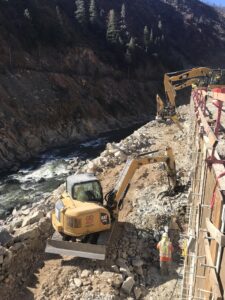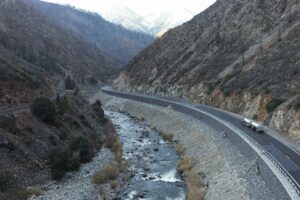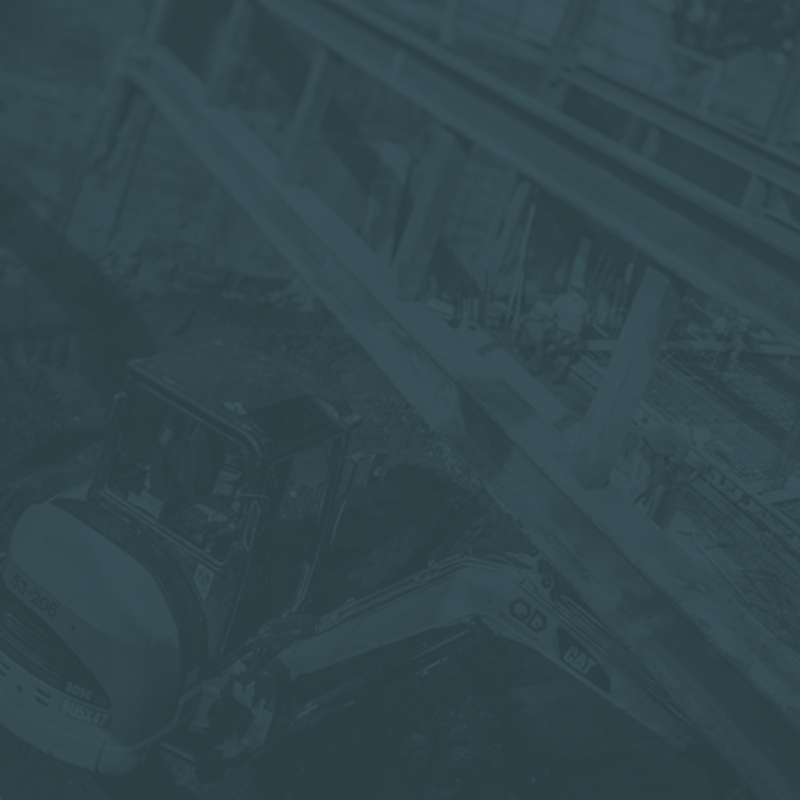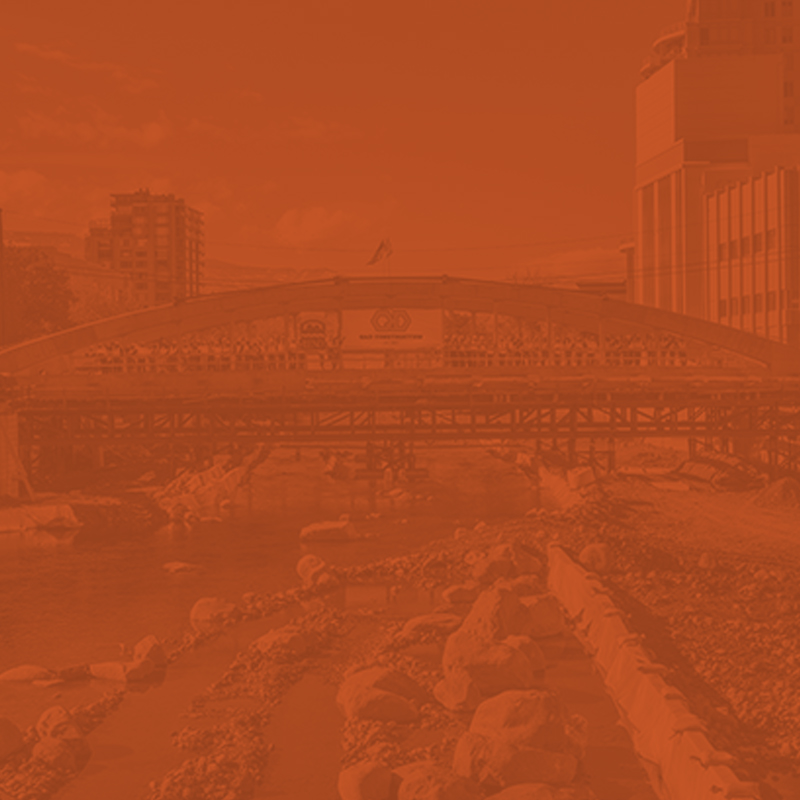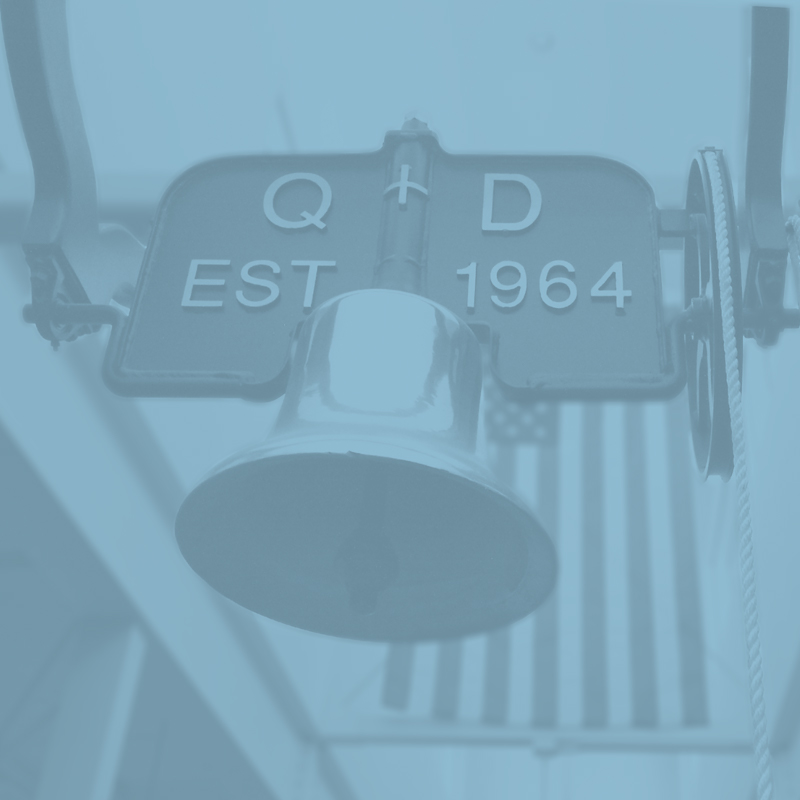The Project
Q&D was contracted to reconstruct a half mile corridor of CA-70 adjacent to the Feather River. This location was prone to being washed out by high river flows following wet seasons. The project consisted of a half-mile soldier-pile retaining wall that averages 17 feet in height with a 12-inch thick cast-in-place wall facing, featuring a rock pattern finish. Additionally, the wall serves to protect the newly realigned section of highway. It also prevents bank scour, protecting the roadway. Essentially the project widened shoulders, moving the highway away from the adjacent steep slope while also improving sightlines for safety. During construction, the Q&D team dealt with serpentine rock, known to contain naturally occurring asbestos. Upon completion, the wall was painted to match the native rock environment, adding aesthetic appeal to scenic byway.
Q&D won the 2024 ENR Northern California Region’s award for Best Highway/Bridge Project
Challenges and Teamwork
The project was delayed from the start when the bid process was set back due to the second-largest wildfire in CA state history – the Dixie Fire, which burned nearly a million acres on and around the project site. The natural disaster left the project site unsuitable to visit for Q&D estimators. Ultimately, the scope of work could not be thoroughly evaluated as planned in July 2021, forcing a delay until November. This forced the contract timeline to be pushed back to a less optimal midsummer 2022 start, shortening the timeline to perform work before winter. This brought on a new challenge. Beams needed for the soldier pile wall had a longer than usual six-month production timeline because of Covid/supply chain impacts. Q&D was able to expedite the beam production by accepting a staggered beam delivery schedule. Next, a Q&D subcontractor proceeded to start drilling 30-inch shafts. However, hurdles quickly arose when underground conditions did not match project bore logs. This issue became the main factor for nearly all challenges ahead, doubling the duration of work in all remaining phases.
In order to overcome challenges, Q&D and CalTrans quickly understood the value of teamwork in salvaging the project. A myriad of issues forced the two entities to constantly innovate out-of-the-box solutions. The contractor and CalTrans formed a proactive committee working to resolve cost implications, giving the contractor confidence to continue moving forward as back-end contractual issues were completed.
Key challenges included:
- Encasing drilling shafts to bottom
- Changed drilling methods, requiring new drill rig and equipment
- Differing initial conditions from geo-tech report provided consistent challenges throughout project
- Implemented work schedule through wettest winter in CA state recorded history
- Multiple mudslides brought highway closures, forcing Q&D to keep multiple suppliers from varying directions available allowing open access to remote project site
- Sinkholes under existing roadway brought delays to excavate those and fill with slurry
- Rural site condition adjacent to river meant environmental challenges and awareness were ever-present
- Difficulty drilling horizontal anchors due to differing site conditions
- Among all job challenges, additional traffic measures implemented to keep traveling public safe and moving
Innovation and Contribution to Industry/Community
The construction was unique for this soldier pile wall. With the river adjacent, the traditional process of digging a ‘bench’ that serves at the foundation was not possible. In order to maintain a construction area and adequate room for the traveling public, a top-down construction method was used. An 80,000-pound drill rig sat on existing roadbed, using down-hole hammer attachments to drill through the boulder-filled embankment. Once the shaft reached tip elevation, a steel beam was placed in shaft and concrete was placed to complete the pile. This tedious but necessary process was replicated for 282 shafts. Thus crews had to drill from the higher side of the soldier pile walls, then install the piles. Next, we had to dig the vertical face out from the top in order to install lagging. Lastly, crews hand chipped grout from beam flanges, allowing construction of the wall that varied from 12-to-21 feet in height – all while keeping at least a single lane of traffic open.
This job’s conditions forced these challenges on our resilient team, however similar wall design and installation methods will not be isolated. They will become even more common as challenging projects require construction of widening roadways in ever tightening urban environments.
Design & Construction Quality
In-situ conditions varied greatly from expectations requiring the project team to think on their feet while changing means and methods on a daily basis. In order to meet the project’s goals, subcontractors utilized three different types of drills simultaneously. The team was required to coordinate nearly just-in- time grout deliveries to have enough material to fill voids from the inconsistent ground conditions around horizontal ground anchors. Subsequently the anchors would be prestressed, re-grouted and permanently tensioned to ensure the required pullout strengths were achieved. This process was developed to compensate for differing site conditions while still delivering desired quality.
The team developed an as-built surveying process to proactively tweak the face of the wall curvature to provide clean and consistent horizontal lines. The difficult drilling conditions caused significant variance between planned pile steel beam locations and their actual locations. If Q&D crews would not have recognized this challenge early on, the results would have been a wall face with a series of tangential lines rather than smoothed curves. Project craftsmen recognized this challenge and developed the survey method to allow early adjustments, avoiding significant deviations.
The same foresight was used to plan the architectural form liner. The team planned horizontal locations and heights of footing steps to keep form liner grout lines to match as intended and ensure that the bottom of the form liner was always buried below finished grade.
"We at CalTrans contracted with Q&D on this project to improve a section of CA highway PLU 70 that had been regularly washing out following relentless Sierra Nevada storms and wet winters. After the storm of 2017, a Federal Permanent Restoration project was initiated and streamlined into Construction. The fast project delivery of the contract required that the subsurface exploration to be minimal. This led to a mischaracterization of the site for construction and provided many challenges to construct the project per the contract plans and specifications. These challenges demanded engineering judgment that required constant and persistent efforts on both parties to meet the construction schedule and execute activities in a manner to produce an exceptional high-quality project that was consistent with the Engineer’s intent. The project was further complicated by
covering approximately 30 miles of the PLU 70 corridor.
The project challenges were not just limited to the geotechnical inconsistencies. Other difficulties included wildfire and other natural climate delays, supply chain availability and continuous logistical hurdles relating to site access. It was apparent from the project’s early stages that we at CalTrans and Q&D needed a strong, communicative partnership to complete this job successfully. As the project was nearing the end of another construction season without completion, we made a commitment to prevent any further delays continuing to escalate the cost. An issue verifying the JMF could have delayed the paving of the project until the following season. Sound engineering judgement teamed with the contractor’s commitment to allocate resources, allowed the project to be completed in late 2023. The quality of the finished project is better for it, as is our strong working relationship moving forward.
I look forward to more CalTrans projects with Q&D in the future."Mike Zdenek - CalTrans PE
Project Overview
Location
Plumas County, CA
Client
CalTrans
Completion Date
Spring 2024
Designer
CalTrans
Awards
2024 ENR Northern California Region's award for Best Highway/Bridge Project



